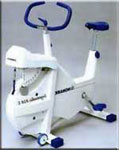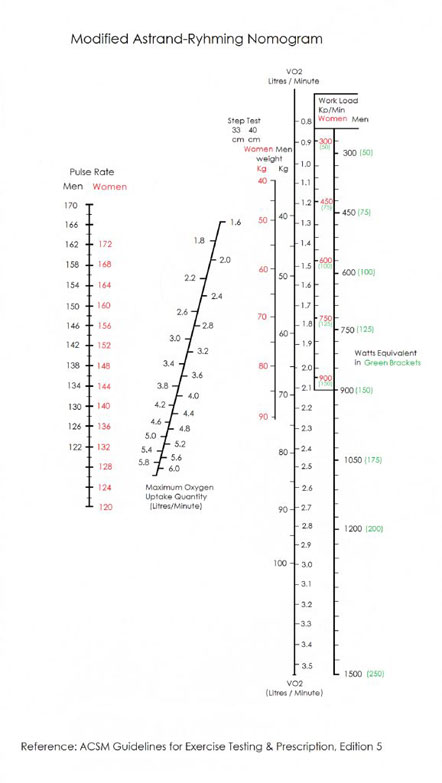

Astrand 6-minute Cycle Test
Testing and measurement are the means of collecting information upon which subsequent performance evaluations and decisions are made. In the analysis, we need to consider the factors influencing the results.
Astrand P.O. devised the Astrand 6-minute Cycle Test in 1956.
Objective
The objective of this test is to monitor the athlete's VO2 max.
Required ResourcesTo conduct this test, you will require:
|
 |
How to conduct the test
- The assistant weighs and records the athlete's weight
- The athlete warms up for 10 minutes
- The assistant sets the initial cycle work rate kg-m/min (kilogram-force meter/minute) as follows:
- Male under 35 – 125
- Male 35-55 – 115
- Male over 55 – 85
- Female under 35 – 115
- Female 35-55 – 85
- Female over 55 – 60
- This setting should raise the athlete's heart rate to 130-160bpm after 2 minutes of cycling at 60rpm
- The assistant gives the command “GO” and starts the stopwatch
- The athlete pedals at 60rpm for 6 minutes whilst maintaining their heart rate between 130-160bpm
- The assistant records the athlete's heart rate each minute
- After 2 minutes - if the athlete's heart rate is not in the target range of 130-160bpm, then the assistant adjusts the work rate wattage accordingly
- The assistant stops the test after 6 minutes and records the final work rate wattage
1 watt is equal to 3600 J/hr, or 6.1183 kg-m/min
Assessment
If the estimated values are 0.00, then the values you entered are outside the specified ranges, and you will need to use the Astrand-Rhyming Nomogram (PDF copy) to obtain your estimates.

For an analysis of your VO2 max score, see the VO2 max page.
Analysis
The test result is analysed by comparing it with the athlete's previous results for this test. It is expected that the analysis would indicate an improvement in the athlete's VO2 max with appropriate training between each test.
Target Group
This test is suitable for endurance athletes and players of endurance sports (e.g. football, rugby) but not for individuals where the test would be contraindicated.
Reliability
Test reliability refers to a consistent and stable test measuring what it is intended to measure. Reliability will depend upon how strict the test is conducted and the individual's level of motivation to perform the test. The following link provides various factors influencing the results and therefore, the test reliability.
Validity
Test validity refers to the degree to which the test measures what it claims to measure and the extent to which inferences, conclusions, and decisions based on test scores are appropriate and meaningful. This test provides a means to monitor training on the athlete's physical development. There are published VO2 max tables, and the correlation to the actual VO2 max is high. For assessing your VO2 max, see the VO2 max normative data tables.
Advantages
- Minimal equipment required
- Simple to set up and conduct
Disadvantages
- Specialist equipment required
- Assistant required to administer the test
References
- ASTRAND, P.O. and RYHMING, I. (1954) A nomogram for calculation of aerobic capacity (physical fitness) from pulse rate during submaximal work. J Appl Physiol, 7, p. 218-221.
Page Reference
If you quote information from this page in your work, then the reference for this page is:
- MACKENZIE, B. (2007) Astrand 6-minute Cycle Test [WWW] Available from: https://www.brianmac.co.uk/cycle6min.htm [Accessed